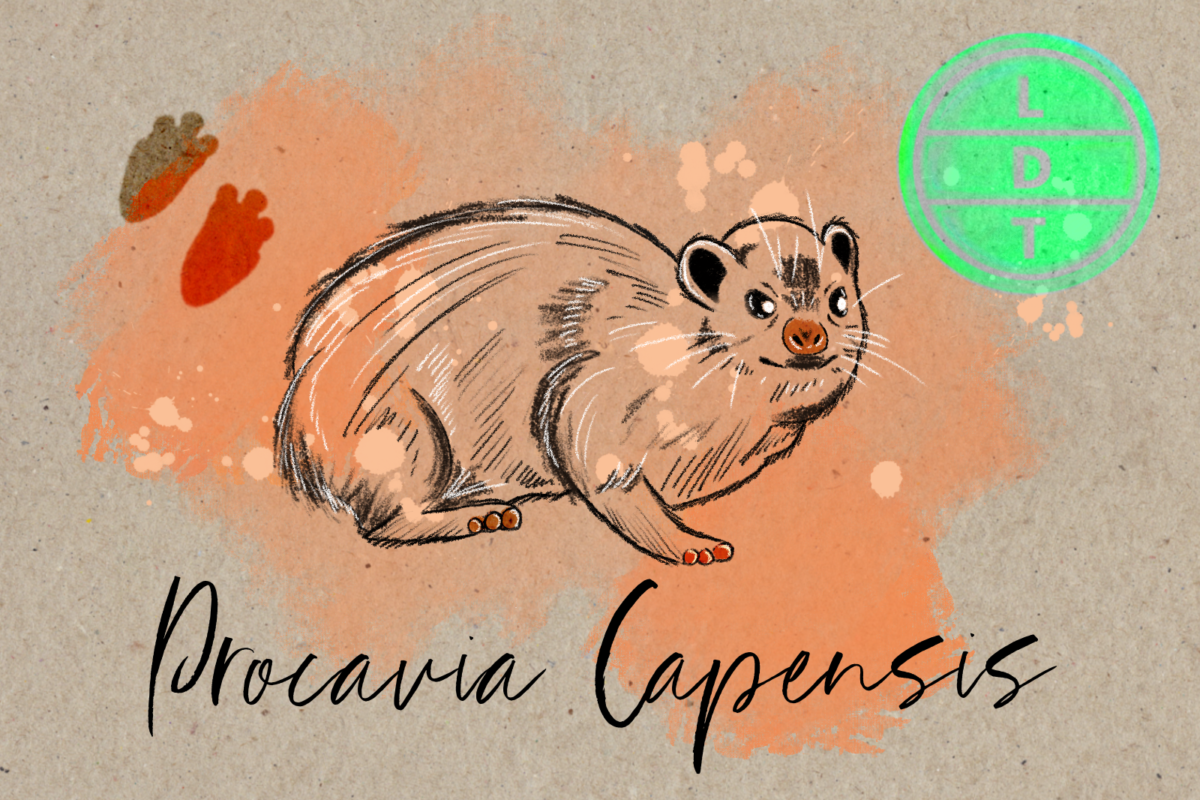“…and today we forgot to say an intro blurb because we had housekeeping stuff.”
Life among the rocks provides cover from predators and a quick escape when necessary, but it also comes with its challenges. But the rock hyrax has accepted the task of adapting to this rugged terrain. For a nice warm spot to take a nap, these unique little mammals have the perfect bodies for their rough environment. But we know adaptation is the name of the game in Life, Death, and Taxonomy.
Description
- The hyrax is a loaf of bread with a hamster face – end of description let’s move on to measure up
- Like if you overfed a weasel
- It’s a large rotund rodent with short legs, a nubby tail, and a little mouse/wombat face.
- Its fur is dark brown on its back and fades into cream-colored on the belly and chest.
- It has beady black eyes and short, round ears
- Like if a quokka, a wombat, and a hibernating grizzly had a baby
Measure Up
Welcome to the beloved Measure Up segment. The official listener’s favorite part of the show! The part of the show when we present the animal’s size and dimension in relatable terms through a quiz that’s fun for the whole family. It’s also the part of the show that’s introduced by you when you send in audio of yourself saying, singing, or chittering the words Measure Up into ldtaxonomy at gmail dot com.
- Leopard gecko
- American pika
- Marmot
- Muskrat
Length
- 50 cm (20 in)
- How many rock hyraxes go into the current distance of the James Webb Space Telescope?
- Hint: The telescope was designed for broad range space research including deep space study. It will be capable of viewing some of the farthest objects we’ve seen in the Universe. It was launched on Christmas Day 2021.
- 2,696,370,336 rock hyraxes. The telescope was 851,140 miles (1,369,777 km) away at the time of recording.
Weight
- 4 kg (8.8 lb)
- How many rock hyraxes go into the current record for men’s elephant bar deadlift?
- Hint: An elephant bar is longer than a standard olympic bar with extra space on both sides to hold plates. The bend of the extra long bars is reminiscent of older style lifts with Hummer tires. The current record was set by Hafthor Bjornsson in 2019.
- 118 hyraxes. The current record is 1,046 lbs (474.4 kg)
Fast Facts
- Range: Lives in mid-Africa and the Middle East as far north as Israel and Jordan and as far east as Oman. South of the Sahara and north of the Kalahari. There is also a population in South Africa and the surrounding countries. I’ve actually seen several of these little guys in the wild at the top of Table Mountain in Cape Town.
- Diet: Herbivorous, but they will also eat insects and grubs if a slimy yet satisfying one comes along.
- Behavior:
- They spend 95% of their time resting – like cats or teenagers
- They do need to keep an eye out for leopards, cobras, pythons, caracals, wild dogs, hawks, and owls. They’re slow and chunky.
- They actually have very complex vocalizations
- Just by measuring the length, pattern, frequency, and complexity of their cries, researchers can tell their age, social status, size, body weight, and even hormonal state.
- There are four social statuses that a male hyrax can have:
- Territorial – dominant males
- Peripheral – solitary roamers that can become dominant if the territorial male is missing
- Early Disperser – juveniles that left their birth site early
- Late Disperser – juveniles that left late after 30 months
Major Fact: Petra Pachyderm
Rock hyraxes are well adapted to their life among the Dwayne Johnsons. Even though they are mammals, they have incomplete thermoregulation, which means they aren’t as good at regulating their body temperature as other mammals.
In order to make it through cold nights, they need to spend time soaking up rays during the day. They spend up to 95% of their time basking on rocks in the sun. They will even make hyrax piles, where they stack on top of each other to maximize warmth, which is called heaping.
However, laying out on hot rocks puts them at risk of being served up on a granite platter to one of their major predators, the black eagle. Black eagles hunt by soaring overhead and swooping down when they spy a meal.
But hyraxes post entries to keep an eye out, and they have an interesting adaptation to help them scan the skies. Their irises, which is the aperture that opens and closes your pupil, protrudes out over their pupil. This allows less light to come into their eyes from above, acting as a tiny little sun visor.
Hyraxes also have another interesting adaptation for living in rocky areas. They look like rodents but they are not tiny capybaras. One of the telltale differences is their feet. The hyrax foot looks different from the typical rodent spindly digits. Like people and bears, their fore feet are plantigrade, which means their feet and heels are flat on the ground. But their back feet are semidigitigrade like elephants and hippos.
From the top, they almost look like elephant feet: little pillars with black circle toes poking out. However, when they lift their sole to reveal their beans, you can see a smooth area in the center. The center of their foot pad can be articulated up to form a vacuum seal. This allows them to suction cups to rocks like it’s mission impossible. They are also kept moist with sweat secretions.
Ending: So get your daily rest, keep a sharp eye out, and be sure to scream your age, body weight, and hormonal status to your fellow mammals like the rock hyrax here in LDT.

